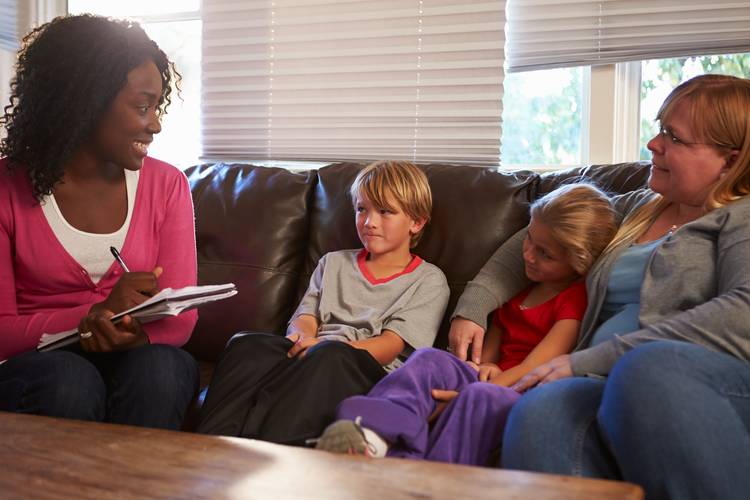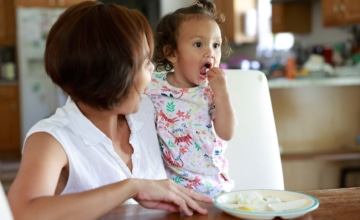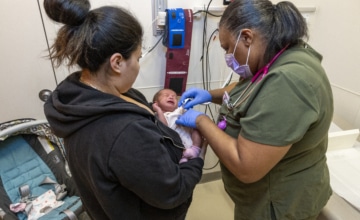Faith Eidson, Alliance for the Advancement of Infant Mental Health
Monica McDonough, Arizona Department of Child Safety

Abstract
Building professional relationships and collaboration are key components to providing effective quality services to infants, toddlers and families involved in the child welfare system. However, it seems many programs and systems continue to work independently of each other, perhaps to the detriment of our most vulnerable children and families. This article offers the story of a mental health professional and a child welfare professional who join forces to create strong professional relationships in a rural community on behalf of young children and families jointly served by their organizations. The story describes how a strong working alliance was forged, how reflective practice and supervision was implemented to the benefit of the community and how sharing key infant mental health concepts and principles led to more positive outcomes for court-involved infants, toddlers, and families.
“In our suffering and joy we are connected to one another with unbreakable and compelling human bonds. In that knowing, all of us become less vulnerable and alone.” —Rachel Naomi Remen
Sara was 4 months old and living in a foster home. Her mother, Katie, was busy with inpatient treatment 64 miles away. Two days a week, a parent aide picked Sara up and buckled her into a car seat for her 90-minute commute to visit her mother at the rehab center. The visits lasted 2 hours. Following the visit, the aide packed Sara back into the car for the hour and a half return home. The 5-hour day was long and exhausting for the baby. Sara often missed her scheduled naps; her feedings were sometimes skipped or not on time. It took 2 days for Sara to recover from her travels each week. Sadly, she displayed worrisome symptoms such as long bouts of crying, difficulty falling asleep, and gastrointestinal irregularity.
Two professionals, one from mental health and one from child welfare, came together and wondered, “What could be done for Sara?” Through a shared understanding of an infant’s need for a primary caregiving relationship, as well as a solid mutual trust in one another, the two professionals considered Sara’s needs and identified a solution. Sara’s mother, Katie, would travel to Sara.
Sara was only one of many children involved in the child welfare system who were being transported long hours and distances to visit with parents—until the question was raised, “Why aren’t the parents traveling to the visits with their infants and young children?” The system listened and implemented the change which soon spread to surrounding counties in the rural region.
As research regarding the effects of trauma on infants and toddlers has grown, so too has the number of infants, toddlers and families who are identified by professionals as in immediate need of increased support. The most vulnerable of these children and families often find themselves interacting with the child welfare system. Many of those same families are also accessing mental health services. Both systems offer support and resources that are strengthened when the systems begin to work together.
According to the 2016 Administration for Children and Families Child Maltreatment Report, a total of 190,776 children ages birth to 3 were identified as victims of substantiated abuse or neglect. Even more staggering, these numbers only represent 17% of all child protective services investigations for children under 3 years of age nationally. The remaining 83% of investigations of children under 3 were unsubstantiated, yet we know that these children still face high risks for poor outcomes, including developmental delays, learning difficulties and symptoms of depression and anxiety (Center on the Developing Child, 2013). This indicates a much greater need for focused attention on services for infants and toddlers and their caregiving families across the country.
Child welfare services aim to protect children from abuse and neglect. Child welfare begins with investigating allegations of maltreatment of children by their caregivers. The work continues with families through assessment and analysis of safety and protective capacities which lead to decisions for the most appropriate level of intervention. The level of involvement by the child welfare system can range from providing voluntary services to the family in their home to removal of the infants or child(ren) and placement in the foster care system.
Infant mental health informed services are designed to support infants, young children, and families and come in many forms. There are a variety of home visiting programs that focus on the social, emotional, and educational needs of infants and toddlers in the context of their primary caregiving relationships. For the purposes of this article, we will discuss infant mental health services that have a mental health intervention component. Specifically, the services provided by the behavioral health program referenced later were modeled after the Michigan Infant Mental Health Home Visiting program, which emphasizes the need for a relationship-based intervention that includes concrete assistance, advocacy, supportive counseling, emotional support, and infant/young child-parent psychotherapy (Weatherston, 2000; Weatherston & Tableman, 2015).
The consequences of maltreatment are devastating, and there are a variety of agencies and professionals, as described above, who stand ready to support struggling families. Often, professionals serving these vulnerable babies and families find themselves weighed down by stories of abandonment, unresolved loss, abuse and neglect, and by the interminable workload. This can lead to isolation and immobilization, as each professional and each system works hard to override the feelings of helplessness and hopelessness that inevitably emerge. A sense of failure and powerlessness can also lead professionals to feel angry and, as a consequence, blame others when things don’t go the way they wanted, further increasing the isolation.
Building Intra-Agency Relationships: One Relationship at a Time
The two of us, Monica McDonough and Faith Eidson, worked for different agencies in the same rural county in Arizona. Monica was a Department of Child Safety (DCS) supervisor and Faith had recently taken the Program Supervisor position for a young and small behavioral health program serving children ages birth to six and their families. At the time we met, 100% of the referrals to the behavioral health program came from DCS, meaning all of the families were involved with the child welfare system. We quickly understood that strong community collaboration would be essential to ensuring effective services for all of the children and families referred. We stumbled upon many barriers to successful collaboration, including the staggering lack of shared understanding, common language, or mutual trust in relationships. Leaders of agencies in our community were unclear about expectations around communication between agencies. Child welfare and mental health professionals often felt they did not have the time to work on building intra-agency relationships. The level of mistrust among the professionals was high due to the toxicity of the work and the culture of self-preservation that had been harnessed for years. However, we held a shared belief that relationships matter. Together, we carried out what we believe are three essential elements for effective community collaborations: taking time to build relationships, effective communication built on shared purpose and language, and frequent and accessible opportunities for reflective conversations and supervision.
In the Beginning-Relationships Matter
“Do unto others as you would have others do unto others.” —Jeree Pawl & Maria St. John, 1998
A core value of infant mental health is that relationships matter (Pawl & St. John, 1998). This belief is built upon the understanding of the power of attachment relationships to affect growth and development in early childhood (Bowlby, 1969). Equally important is the understanding that a baby’s good mental health is directly correlated with the strength of her relationships with primary caregivers (Fitzgerald, Weatherston & Mann, 2011). Third, Jeree Pawl and Maria St. John remind us that “how we are is as important as what we do … “ (Pawl & St. John, 1998). These cornerstones of infant mental health informed practice have led service providers to focus intentionally on how they enter into and build relationships with parents and families. Parallel to that, professionals strive to provide a strong and nurturing secure base for parents, in the hope that the parents will be able to transfer the lived and often corrective experience of safety and comfort through their relationships with their babies.
Believing that relationships affect relationships, professionals also need to be supported in building positive working relationships with other professionals outside of their own agencies (Emde, 1991; Harden, 1997). As supervisors, it was our job to model this value through our actions. We accomplished this by engaging in ongoing respectful communication, offering presence and careful listening, and always coming together to repair the relationship when there was conflict.
Our Story: Faith and Monica
We (Faith, a mental health supervisor, and Monica, a child welfare supervisor) were each experiencing difficulties with individual staff in each of our systems who were not getting along during meetings in which both systems were discussing work with the families they shared. We knew we needed to talk but we each remember feeling afraid, wondering how the other would react to a call about a problem employee. Neither of us can remember who called first, but as supervisors we initiated a conversation between the two of us to come to a common understanding of how to work together on behalf of the infants, young children and families referred. Following the phone call, we both recall feeling immediately calmed by the honest and kind presence of the voice on the other side of the phone. Instead of blaming, each of us came to the call with a clear understanding of what our organization and employee brought to the difficult interaction, and with a willingness to listen and learn. This freedom in expressing vulnerabilities between two supervisors from two distinctly separate agencies was unheard of and a brand new experience for both. We both left the call feeling like we had found someone who “got it.”Following the initial call, we set up a meeting with all our staff; it was an opportunity for us to model healthy communication and mutual understanding of the work we were doing for our families. We listened to one another’s perspectives as both child welfare staff and behavioral health staff, provided reflection, and discussed strategies to improve our meetings with families. A week or two after the meeting Faith sent a card in the mail to Monica at the DCS office. She had taken the time to “mark” the important beginning of a relationship and mailed a thank you card to express her appreciation for the time spent together working with our employees and a wish for continued successful work with one another. The kind regard and thought behind sending a card was especially moving to Monica who rarely received acknowledgments, much less thank you cards. Looking back, we both recall feeling connected, seen and understood as a result of this experience.
A Simple Beginning
This interaction may seem simple, yet it became a strong beginning to a much deeper and richer professional relationship. The phone call, meeting and thank you card became the first building blocks for a relationship built on trust and mutual respect. Just as in infant–parent relationships, trust is built in the tiniest of moments throughout each day; the ways in which needs are communicated and met and experiences and feelings are held and nurtured. From this interaction forward, we never hesitated to pick up the phone and talk with each other. Blame was no longer our first way of reacting to a hard story that involved both of our agencies. We came to each other assuming the best of intentions, and understanding that we could work out many problems, together.
The Power of Reflective Supervision
“Start where you are, use what you have, do what you can, it will be enough.” —Theodore Roosevelt
About a year after we began our professional relationship, Faith’s agency received a contract to provide infant mental health training and reflective supervision to multi-disciplinary groups in the community, for which Faith would be the provider of reflective supervision/consultation (RS/C). The primary goal of this group was to support professionals in the community in earning professional recognition for the work they were doing through the Endorsement for Culturally Sensitive Relationship-Focused Practice Promoting Infant Mental Health® (IMH-E®). The IMH-E® was developed by the Michigan Association for Infant Mental Health, and the Infant Toddler Mental Health Coalition of Arizona, recognizing the need for a competent and supported infant-toddler workforce, purchased the license to implement Endorsement® in Arizona. Key components, necessary for a professional to earn IMH-E®, are specialized training and reflective supervision. Monica immediately signed up to be a part of these groups. Reflective supervision was still a new concept in our rural community; however, some home visiting programs were beginning to implement the common components into their supervisory meetings. Reflective supervision consultation (RS/C) offers a relationship-focused opportunity for professionals to explore their work through multiple lenses. It also allows professionals to slow down, to recognize their own reflexive reactions and to practice more reflective responses to their work in a safe environment (Heffron, 1999). The Reflective Interaction Observation Scale (RIOS™) (Watson, Harrison, Hennes, & Harris, 2016) provides a framework for understanding the unique components of Reflective Supervision/Consultation. The Essential Elements of reflective supervision include the development of a working alliance, a professional use of self, focusing on the details and a shared understanding of the story, keeping the baby in mind during the discussion, and attending to the parallel process (Watson, et al., 2017). With this model in mind, we formed multidisciplinary reflective supervision groups and the work began.

Reflective supervision consultation (RS/C) offers a relationship-focused opportunity for professionals to explore their work through multiple lenses. Photo: Monkey Business Images/shutterstock
An Interdisciplinary Reflective Supervision Mode
The reflective groups consisted of a vast array of professionals in the community: child welfare, mental health, foster care, home visitation, education, and legal. We came together for trainings focused on infant toddler mental health. The group experience began with three half-day trainings that included content in the basics of infant mental health, attachment, parallel process, relationship-based work, and reflective supervision. Reflec-tive experiences were woven throughout the training days. Participants were invited to reflect on their own early childhood experiences and to practice the art of listening. Having an opportunity to reflect on their own childhood experiences allowed them to remember and honor the infants and toddlers inside of them and use that as a perspective to take when working with infants and toddlers on our caseload. What was surprising was the impact it had on each of the participants when asked at one session to bring a picture of themselves as babies or toddlers to the next session. Monica’s experience with this exercise was one of excitement to share her story but also one of sadness as if this “young Monica” was a long lost friend who had not been remembered for years and years. Feelings of guilt welled up at having forgotten a piece of herself.
Additionally, one of these training days included a “fishbowl experience,” a common strategy for training in RS/C in which the group is able to observe a live and unscripted RS/C session and the group is invited to reflect together about the experience. Monica remembers this as being a pivotal moment for her in her professional development. While observing the RS/C, Monica was overwhelmed with feelings. When it came time to share each person’s experience, Faith noticed that Monica was struggling to silence her free-flowing tears. When Faith asked Monica about the tears, Monica expressed not wanting to cry “because I’m afraid I won’t be able to stop.” All the years of listening to stories of children’s pain and families’ suffering came to the surface after having been buried away, forgotten and hidden by piles of paperwork and distractions moving “on to the next crisis” with “no time to waste.” These children, these families, these stories, had been forgotten just like the little Monica who had not been remembered.
When all participants had completed 3 days of infant mental health training, they divided into smaller groups that met monthly for 2 hours to practice reflective supervision together, with Faith serving as the reflective consultant. It was important that the groups met regularly and consistently so that over time the group members found the experience predictable and safe, and therefore were able to develop trust in each other and in the process. This trust became the foundation for the important work the groups did together as each group member brought their worries, fears, and conflicts within their work with infants and families for the group to consider together. They also shared their joys and successes, finding a common purpose and way of understanding their unique work with infants, toddlers, and families. Later, group members reflected on the permission that Monica’s vulnerability in the first RS/C observation allowed them to feel, trust, and be present for one another. They said, “If Monica could do it, so can we.” The power of this group’s reflective experience seemed to begin with one person being brave enough to take the leap, already sensing there was a net below to catch her. The net was united by the group who sat ready to catch and hold each other’s stories each month. Sadly, after 18 months, the funding was not renewed and the multiple groups were forced to end. However, a group of eight professionals, including Monica, were determined to continue this process. They had already felt the effects of their individual work, and in their work with each other across teams and agencies. This smaller group of professionals from child welfare, legal teams, program directors, home visitors, supervisors, and therapists joined forces for a participant-funded reflective group that has continued, with some changes over time in participants and in consultants, in the community for approximately 7 years.
It was obvious and perhaps expected that the reflective practice experienced in this group, for just 2 hours a month, was powerful and transformative for each individual. However, what felt surprising for all was how the two hours spent practicing true presence and mindfulness together each month affected entire community systems in powerful ways. No longer did group members, or their staff, regularly show up to family team meetings defensive and angry. Instead, there was a shared sense of purpose, and a new understanding and compassion for the “other.” Empathy became a key way in which group members interacted with each other, and this experience was shared, both implicitly and explicitly, with their colleagues, supervisees, and agencies.
Speaking the Same Language
“Do the best you can until you know better. Then when you know better, do better.” —Maya Angelou
Over time, the relationship between us continued to grow and blossomed into a true partnership across systems. Monica quickly felt the power of reflective supervision, and soon she entered into an individual RS relationship with Faith in addition to the experience of the RS group. Together, we discussed feeling powerless. It became excruciatingly clear that one of the largest barriers to community collaboration was the lack of fundamental knowledge about what babies need to better assure positive and healthy outcomes. We watched repeatedly as well-meaning representatives from across our county talked but never communicated. We could see that if they only knew what we knew, if they could all join together around their passion for the well-being of babies, as we had, there was potential for better outcomes for infants, young children and families involved with the child welfare system.
This observation, once put into words, led us to create a training together that included the most basic and important facts about babies, families, infant mental health, the behavioral health system and the child welfare system. We made the training 3.5 hours so that groups could complete it in half a day, knowing that many court staff rarely had more than that for training hours.
To implement the training, we started right at home, with our own teams. We learned immediately that one of the most powerful parts of the training was the experience of seeing supervisors from across agencies presenting the same information, but with the perspectives from their own systems. Monica’s child welfare workers did not need one more mental health person telling them things that just made doing their job harder and left them feeling powerless. However, hearing the information and then learning how Monica was able to integrate infant mental health principles into her work made the information seem relevant and useful. Similarly, the mental health team often felt frustrated because it sometimes seemed to them that the child welfare system was working against them. They were able to learn from Monica what the barriers for child welfare workers were, and they were able to see their supervisor show empathy and compassion for the professionals facing those barriers. They watched as we both acknowledged our systems’ challenges and then shared our passion for what could be done. We believe they felt hope when they left our training: hope that our systems could be improved and hope that they could absolutely be stronger advocates for babies and families.
Over time it became clear that the message needed to reach further afield. Child welfare and mental health could speak the same language and understand the importance of the unique experiences of infants and toddlers, but it was all for naught if the entities making decisions for babies did not have the same understanding. Judges, attorneys, guardians ad litem (GAL) and Court Appointed Special Advocates (CASA) needed to understand what babies need too. Repeatedly, we as professionals would leave the courtroom dismayed by the decisions being made without the forethought of the impact on the baby. Our messages were being ignored, our language was not translating effectively to those with the power. We began presenting our training to the local county court team and then extending the offer of our training to our sister counties who were all hungry for more information. We brought the training to each of these small rural communities. We didn’t offer the training in the metropolitan area and expect people to travel to us, as was most typical. We shaped the value of our approach toward “being with” them in their home and in their community. Suddenly we saw attorneys and GALs speaking up in court about the child’s attachment relationship, we witnessed CASAs asking for the babies and families to be assigned an infant mental health therapist, and we had judges asking for recommendations and input from the professionals working with the children and families prior to making decisions.
The power of this training was not always the content. It seemed that the interdisciplinary professionals in the room were finding their way to each other, connecting over a shared concern for infants and very young children in their systems. We often received messages from participants who previously attended the training that the shared language with other professionals allowed them to communicate more effectively. Their messages conveyed a sense of hope. With each group we trained, we felt the momentum of progress growing.
Conclusion
As we look back, it seems inconceivable that one small gesture, a handwritten note sent in the mail, led to the kind of community collaboration we witnessed. We often do not realize the impact we have on the path of another, and on our communities, when we reach out and connect. Our story highlights the power of professional relationships and collaboration. We were able to foster community collaboration that positively impacted the lives of the children and families involved with the child welfare system in our state. We learned that we are not powerless, and that professionals and systems can do great things for families experiencing difficult circumstances if they work together compassionately. In our time together, we led and supported this community collaboration effort by building strong working relationships across systems, engaging in ongoing reflective supervision relationships, and offering carefully selected information broadly to create a foundation for shared language and understanding about what babies and families need in order to be safe and healthy. We are confident that we made a difference. Though we no longer live and work in the same community, we have both taken the foundation of our shared success to impact change on behalf of babies, young children, and families and applied it in everything we do.
Sara, the 4-month-old infant described in the introduction to this article, and her mother, Katie, greatly benefited from our collaboration. Once we implemented the change, Katie traveled to see Sara for visits, allowing Sara to stay in an environment familiar to her. In time, Sara began to show more pleasure in her interaction with Katie. She was more alert during visits and smiled brightly during play. Sara’s mom, Katie, also seemed to enjoy her time with Sara, commenting on how much she babbled when they were together and expressing some delight in holding her on her lap and introducing a new toy. The two were coming to know one another in a new, more settled way. Sara’s foster parents reported immediately, within the first weeks of the change, that Sara’s sleep was no longer disrupted for days at a time after each visit. They said that she appeared curious about her surroundings and, although fussy, could be comforted. Within several more weeks, Sara’s foster parents reported that she was far less irritable and that her gastrointestinal irregularities were disappearing. While Sara continued to transition between two homes for quite some time before she reached permanency, the success and pleasure she was able to experience in her early developing relationships became a strong and key protective factor.
Learn More
Infant Mental Health Endorsement®, created by the Michigan Association for Infant Mental Health and adopted by 29 state and 2 international IMH associations, is a competency-based credentialing system for multidisciplinary professionals working with or on behalf of infants, toddlers and families and who are also applying the lens of infant mental health principles to their work.
Professionals who have earned Endorsement® have demonstrated completion of specialized work experience, in-service training, and reflective supervision/consultation experiences that have led to competency in the promotion and/or practice of infant mental health.
Authors
Faith Eidson, LMSW, IMH-E® is the Quality Assurance Manager for the Alliance for the Advancement of Infant Mental Health®. Faith works to support Alliance member associations in assuring quality and standards for reciprocity in the Endorsement®system across the Alliance. Before joining the Alliance staff, Faith served as an infant mental health therapist and as a clinical and reflective supervisor for infant and early childhood mental health programs in both Michigan and Arizona. She is endorsed by MI-AIMH as an Infant Mental Health Mentor–Clinical. Faith also currently provides reflective consultation and training to professionals in the infant-family field. Faith’s training includes a Bachelor’s degree in Psychology and a Master of Social Work, both from the University of Michigan.
Monica McDonough, LMSW, IMH-E® is a Program Manager with the Arizona Department of Child Safety (DCS). Monica has been employed with Arizona DCS for 20 years. In her current position as Program Manager she oversees four child welfare units (investigations and ongoing case management) in three separate counties in Southeastern Arizona. She has maintained her Infant Family Specialist Endorsement, is an Endorsement Advisor for Infant Toddler Mental Health Coalition of Arizona (ITHMCA), and provides reflective supervision and consultation. Monica’s training includes a Bachelor of Social Work degree from Northern Arizona University and a Master of Social Work degree from Arizona State University.
References
2016 Administration for Children and Families Child Maltreatment Report.Bowlby, J. (1969). Attachment. New York: Basic Books.
Center on the Developing Child. (2013). The science of neglect (InBrief). https://developingchild.harvard.edu/resources/inbrief-the-science-of-neglect
Emde, R. (1991). The wonder of our complex enterprise: Steps enabled by attachment and the effects of relationships on relationships. Infant Mental Health Journal, 12(3), 164–173.
Fitzgerald, H. E., Weatherston, D. J. & Mann, T. L. (2011). Infant mental health: An interdisciplinary framework for early social and emotional development. Current Problems in Pediatric and Adolescent Health Care, 41, 178–182.
Harden, B. J. (1997). You cannot do it alone: Home visitation with psychologically vulnerable families and children. ZERO TO THREE, 17(4), 10–16.
Heffron, M. C. ( 1999). Balance in jeopardy: Reflective reactions vs. reflective responses in infant/family practice. ZERO TO THREE, 20(1), 6–17.
National Scientific Council on the Developing Child. (2005/2014). Excessive stress disrupts the architecture of the developing brain: Working Paper No. 3. Updated edition. https://developingchild.harvard.edu/resources/wp3
Pawl, J. & St. John, M. (1998). How you are is important as what you do … in making a positive difference for infants, toddlers and their families. ZERO TO THREE: National Center for Infants, Toddlers and Families, Washington, D.C.
Watson, C., Harrison, M., Hennes, J., & Harris, M. (2016). Revealing “The space between”: Creating an observation scale to understand infant mental health reflective supervision. ZERO TO THREE, 37(2), 14–21.
Watson, C., Harrison, M., Hennes, J., & Harris, M. (2017). Reflective Interaction Observation Scale (RIOS) Manual. St. Paul, MN: University of Minnesota, Center for Early Education & Development.
Weatherston, D. (2000). The infant mental health specialist. ZERO TO THREE, 21(2), 3–10.
Weatherston, D. & Tableman, B. (2015). Infant mental health home based services: Supporting competencies and reducing risks. Michigan Association for Infant Mental Health, Southgate.




